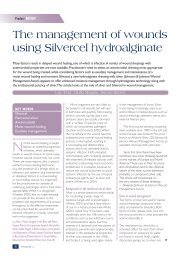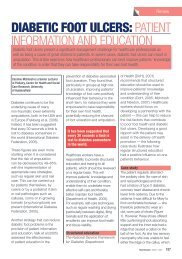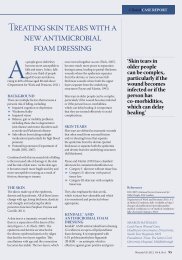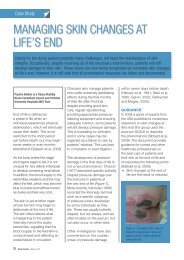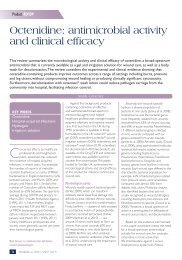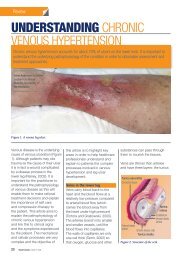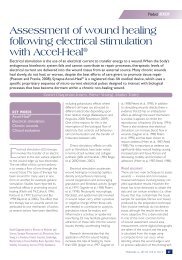WOUND MANAGEMENT AND DRESSING SELECTION - Wounds UK
WOUND MANAGEMENT AND DRESSING SELECTION - Wounds UK
WOUND MANAGEMENT AND DRESSING SELECTION - Wounds UK
You also want an ePaper? Increase the reach of your titles
YUMPU automatically turns print PDFs into web optimized ePapers that Google loves.
Review<br />
<strong>WOUND</strong> <strong>MANAGEMENT</strong> <strong>AND</strong><br />
<strong>DRESSING</strong> <strong>SELECTION</strong><br />
Effective wound management requires an understanding of the process of tissue repair and a<br />
knowledge of the properties of the many sophisticated dressings that are now available. This article<br />
guides the reader through each dressing type and their properties, and examines the types of wounds<br />
that they can be used to dress.<br />
Clare Morris is Tissue<br />
Viability Advisor, North<br />
East Wales NHS Trust<br />
The correct dressing can have a signifi cant<br />
impact on the healing of wounds.<br />
A holistic assessment is essential<br />
before choosing a wound<br />
dressing. Wound assessment<br />
has traditionally been the<br />
responsibility of nurses and<br />
has been a subjective practice<br />
(Williams, 1998a) with a reliance<br />
on anecdotal evidence that is<br />
diffi cult to assess for accuracy.<br />
A holistic approach brings<br />
about a relationship between<br />
the patient, the wound, and<br />
the treatment (Flanagan, 1997).<br />
Accurate wound assessment<br />
depends on an understanding<br />
of several factors (Table 1).<br />
Other important aspects include<br />
measurement and documentation<br />
of wound healing rates and<br />
specialised areas such as leg<br />
ulcer assessment and the risk<br />
178 Wound Essentials • Volume 1 • 2006<br />
of pressure ulcers. The aim of<br />
local wound management is to<br />
provide the optimum environment<br />
for the natural healing process<br />
to occur (Morison et al, 1997).<br />
The different factors involved are<br />
essentially the same, whatever<br />
The correct dressing, used<br />
as part of holistic care of<br />
the patient, can have a<br />
signifi cant impact on the<br />
healing of chronic and<br />
problem wounds<br />
the wound type (Table 2). It<br />
can be diffi cult to select the<br />
correct dressing but with a good<br />
knowledge base the practitioner<br />
should be able to identify the<br />
most suitable and cost-effective<br />
option (Williams, 1998a).<br />
The number and sophistication<br />
of modern wound dressings<br />
available makes selection an<br />
advanced skill — particularly for<br />
complex wounds. The correct<br />
dressing, used as part of holistic<br />
care of the patient, can have a<br />
signifi cant impact on the healing<br />
of chronic and problem wounds<br />
(Casey, 2000).<br />
The principle reasons for applying<br />
a dressing can be summarised as<br />
follows:<br />
8To provide rapid and<br />
cosmetically acceptable healing<br />
8To remove or contain odour<br />
8To reduce pain<br />
8To prevent or combat infection<br />
8To contain exudate<br />
8To cause minimum distress or<br />
disturbance to the patient
8To hide or cover a wound<br />
for cosmetic reasons<br />
(Thomas, 1997).<br />
It is acceptable to combine a<br />
primary and secondary dressing<br />
but it has become common<br />
practice to mix wound dressings<br />
and sometimes combine<br />
three or more products. This<br />
practice can be unsafe and<br />
may give rise to unnecessary<br />
extra costs (Benbow, 1997).<br />
It also demonstrates a lack<br />
of knowledge and insight into<br />
why, when and how a particular<br />
dressing product should be used<br />
(Benbow, 2004). Inappropriate<br />
care can lead to delayed<br />
wound healing for patients and<br />
unnecessarily high costs for the<br />
healthcare provider (Dowsett,<br />
2002).<br />
Before applying any dressing the<br />
nurse should ask:<br />
8What is the action of this<br />
dressing?<br />
8When should it be used?<br />
8What are the limitations/<br />
contraindications to its use?<br />
8Do I know the correct method<br />
of application and removal?<br />
8Do I have sufficient knowledge<br />
about the dressing and have<br />
I been trained to use it?<br />
(Benbow, 2004).<br />
This article will now give an<br />
overview of each dressing<br />
category and the types of<br />
wounds that they can be<br />
used for.<br />
Hydrocolloid dressings<br />
The first hydrocolloid dressing<br />
was introduced in the mid-<br />
1970s. There are now many<br />
types available in a variety of<br />
thicknesses, shapes and sizes<br />
(Williams, 1994). Examples<br />
include:<br />
8Granuflex (ConvaTec,<br />
Ickenham)<br />
8DuoDERM Extra Thin/Signal<br />
(ConvaTec, Ickenham)<br />
8Comfeel (Coloplast,<br />
Peterborough)<br />
8Tegasorb (3M, Loughborough)<br />
8Hydrocoll (Hartmann,<br />
Heywood)<br />
8Aquacel (ConvaTec, Ickenham).<br />
When a hydrocolloid dressing<br />
comes into contact with a wound<br />
the hydrocolloid component of<br />
the dressing becomes a gel on<br />
contact with moisture from the<br />
The hydrocolloid dressing<br />
was originally developed<br />
from stoma products and<br />
was found to provide a<br />
barrier over excoriated skin<br />
wound exudate and creates<br />
a barrier that protects against<br />
infection with micro-organisms<br />
(Williams, 1996a).<br />
Hydrocolloid dressings are<br />
capable of handling a wide range<br />
of exudate from light to very<br />
heavy (Casey, 2000).<br />
The majority of hydrocolloid<br />
dressings are composed mainly<br />
of cellulose. The hydrocolloid<br />
dressing was originally developed<br />
from stoma products and was<br />
found to provide a barrier over<br />
excoriated skin (Williams, 1998b).<br />
Hydrocolloid dressings can be<br />
used in a variety of wounds,<br />
e.g. pressure ulcers, leg ulcers,<br />
surgical wounds, abrasions and<br />
minor burns. They can also be<br />
used in granulating, sloughy or<br />
necrotic wounds and they can<br />
facilitate the rehydration and<br />
debridement of dry, sloughy and<br />
Review<br />
necrotic wounds. The hydrofibre<br />
Aquacel is a development of the<br />
hydrocolloid. This dressing is<br />
composed entirely of hydrocolloid<br />
fibres and is very absorbent. It is<br />
best used in moderate to highly<br />
exuding, sloughy and necrotic<br />
wounds. It requires a secondary<br />
dressing, e.g. DuoDERM Extra<br />
Thin, to hold it in place. Care<br />
should be taken when using<br />
hydrocolloids on clinically infected<br />
wounds as they can encourage<br />
the growth of anaerobic bacteria<br />
(Nurse Prescriber, 2006).<br />
A hydrocolloid dressing size<br />
should be selected to allow a<br />
minimum overlap of 2cm from<br />
the margin of the wound onto the<br />
surrounding healthy skin. Many<br />
allow patients to shower and<br />
bathe and ideally should be left in<br />
place for 3–5 days.<br />
Hydrogel dressings<br />
For many years hydrogel<br />
dressings have been the<br />
main treatment option in the<br />
management of dry wounds<br />
containing slough and/or necrotic<br />
tissue (Young et al, 1997).<br />
Hydrogels contain large amounts<br />
of water — 80% or more — and<br />
are combined with a range of<br />
other materials, e.g. hydrocolloid<br />
materials, alginates and starchbased<br />
polymers (Williams,<br />
1998c).<br />
Hydrogels are available as<br />
a gel with no firm structure<br />
(amorphous) or as sheets.<br />
Examples of amorphous<br />
hydrogels include:<br />
8IntraSite Gel (Smith & Nephew<br />
Healthcare, Hull)<br />
8NU-Gel, Johnson & Johnson<br />
Wound Management, Ascot)<br />
8Purilon Gel (Coloplast,<br />
Peterborough)<br />
Wound Essentials • Volume 1 • 2006 179
Review<br />
8GranuGEL (ConvaTec,<br />
Ickenham)<br />
and sheet gels such as:<br />
8ActiForm Cool (Activa<br />
Healthcare, Burton-on-Trent)<br />
8Curagel (Tyco Healthcare,<br />
Gosport)<br />
8Geliperm (Geistlich Pharma,<br />
Chester)<br />
8Hydrosorb (Hartmann,<br />
Heywood).<br />
Hydrogels donate moisture or<br />
absorb exudate depending on<br />
the state of the wound thereby<br />
providing a moist environment.<br />
This encourages or facilitates<br />
autolysis or debridement of<br />
devitalised tissue from the healthy<br />
wound bed. Hydrogels can be<br />
used in a variety of wound types<br />
and although they are mainly<br />
used in dry, sloughy or necrotic<br />
wounds they can be used during<br />
all stages of wound healing.<br />
Hydrogels have also been used<br />
in other areas of skin and wound<br />
care (Williams, 1995a):<br />
8Dermatological skin conditions<br />
8Inflamed skin flexures<br />
8Skin damaged by radiotherapy<br />
8Extravasation injuries in<br />
neonates<br />
8Excoriation of the skin caused<br />
by incontinence<br />
8Management of fistula<br />
8Nappy rash in infants.<br />
Hydrogels are normally used for<br />
wounds with low to moderate<br />
levels of exudate and the<br />
amorphous hydrogels require a<br />
secondary dressing. As hydrogels<br />
release water to any dry surface,<br />
the use of secondary dressings<br />
that are dry or high-absorbency<br />
such as polyurethane foam is not<br />
recommended (Casey, 2000).<br />
A semi-permeable film is more<br />
suitable.<br />
180 Wound Essentials • Volume 1 • 2006<br />
Alginate dressings<br />
Alginate dressings are formed<br />
from calcium alginate, a<br />
component of seaweed.<br />
Examples include:<br />
8Sorbsan (Unomedical,<br />
Redditch)<br />
8Kaltostat (ConvaTec, Ickenham)<br />
8Tegagen (3M, Loughborough)<br />
8SeaSorb (Coloplast,<br />
Peterborough<br />
8Algosteril (Smith & Nephew<br />
Healthcare, Hull).<br />
In the early 1800s seaweed was<br />
discovered to be very effective<br />
in treating the wounds of sailors<br />
who had been injured in sea<br />
battles. Sailors often referred<br />
to it as ‘the mariner’s cure’<br />
(Williams, 1998d). When alginate<br />
In the early 1800s seaweed<br />
was discovered to be very<br />
effective in treating the<br />
wounds of sailors who had<br />
been injured in sea battles.<br />
Sailors often referred to it as<br />
‘the mariner’s cure’<br />
dressings come into contact<br />
with the wound surface, the<br />
calcium from the dressing is<br />
exchanged with sodium from<br />
the wound exudate. This turns<br />
the dressing into a gel that<br />
maintains a moist environment<br />
(Casey, 2000).<br />
The dressings are suitable for<br />
a wide range of wound types<br />
and cavity wounds that are<br />
granulating, with small amounts<br />
of slough, and moderate to<br />
high exudate levels. They are<br />
unsuitable for dry wounds or<br />
those with dry, hard, necrotic<br />
tissues. It is self-defeating to premoisten<br />
an alginate and use it on<br />
a dry wound — a practice that is<br />
sometimes encouraged (Williams,<br />
1998d). Alginates are ideal for<br />
bleeding wounds because they<br />
are natural haemostats (Williams,<br />
1998d).<br />
Alginates are also atraumatic and<br />
pain-free to remove (Williams,<br />
1996b). They need to be held<br />
in place with a secondary<br />
dressing such as an adhesive<br />
foam dressing or a semipermeable<br />
film.<br />
Semi-permeable film dressings<br />
Semi-permeabile film dressings<br />
are all made from a thin sheet of<br />
polyurethane coated with a layer<br />
of adhesive. Examples include:<br />
8OpSite (Smith & Nephew<br />
Healthcare, Hull)<br />
8Tegaderm (3M, Loughborough)<br />
8Bioclusive (Johnson & Johnson<br />
Wound Management, Ascot).<br />
They are permeable to moisture,<br />
vapour and gases, but are<br />
impermeable to liquids. The<br />
different types of film dressings<br />
differ in their moisture vapour<br />
permeability (MVP), their method<br />
of application, extensibility, weight<br />
and thickness (Williams, 1998a).<br />
Film dressings are suitable for<br />
superficial and shallow wounds,<br />
e.g. those in the final stages of<br />
healing, because they protect<br />
newly epithelialised wounds from<br />
trauma (Casey, 2000). They can<br />
also be used as a secondary<br />
dressing over most primary<br />
dressings, e.g. gels, alginates<br />
and hydrofibres, to retain them<br />
(Williams, 1995b).<br />
Care should be taken when<br />
removing film dressings. Many<br />
have a specific method to break<br />
the adhesive bond to ensure an<br />
atraumatic removal.
Foams — polyurethane,<br />
hydrocellular, soft silicone and<br />
hydropolymer dressings<br />
There are a variety of foams made<br />
from different base materials<br />
and constructions that have<br />
similar but varying performance<br />
characteristics. Foam dressings<br />
are available in a variety of<br />
shapes, sizes and thicknesses<br />
that can be used on medium to<br />
heavily exuding wounds including<br />
pressure ulcers, leg ulcers, burns,<br />
surgical wounds and more.<br />
Examples include:<br />
8Allevyn – hydrocellular (Smith &<br />
Nephew Healthcare, Hull)<br />
8Biatain – polyurethane;<br />
(Coloplast, Peterborough)<br />
8Lyofoam – polyurethane;<br />
(Mölnlycke, Dunstable)<br />
8Mepilex – soft silicone;<br />
(Mölnlycke, Dunstable)<br />
8Tielle – hydropolymer<br />
(Johnson & Johnson Wound<br />
Management, Ascot).<br />
Some come in an adhesive,<br />
bordered format and some are<br />
non-bordered and so are more<br />
suitable for those patients with<br />
delicate or problematic skin,<br />
e.g. leg ulcer patients where the<br />
dressing may be kept in place<br />
with compression bandages.<br />
Foams are recommended for use<br />
in exuding granulating wounds<br />
and are not recommended for<br />
dry superficial wounds. They<br />
are also suitable for use under<br />
compression therapy.<br />
Deodorising dressings<br />
The management of fungating<br />
and malodorous wounds provide<br />
a challenge for many healthcare<br />
professionals (Williams, 1998e).<br />
Deodorising dressings may be<br />
useful in the management of<br />
malodour.<br />
Examples include:<br />
8CarboFlex (ConvaTec,<br />
Ickenham)<br />
8Actisorb Silver 200 (Johnson &<br />
Johnson Healthcare, Ascot)<br />
8CliniSorb (Clinimed,<br />
8Lyofoam C (Mölnlycke,<br />
Dunstable)<br />
8Carbonet (Smith & Nephew<br />
Healthcare, Hull).<br />
Many of the dressings contain<br />
charcoal cloth that is able to<br />
absorb gas molecules. Some<br />
deodorising dressings are<br />
combined with other dressing<br />
products such as foam, silver,<br />
alginates and absorbent pads.<br />
Iodine dressings<br />
Iodine-based products are<br />
antiseptics and act on a broad<br />
spectrum of micro-organisms.<br />
Examples include:<br />
8Inadine (povidone iodine)<br />
Johnson & Johnson Wound<br />
Management, Hull)<br />
8Iodoflex/Iodosorb (cadexomer<br />
iodine) Smith & Nephew<br />
Healthcare, Hull).<br />
Inadine is presented as a<br />
low-adherent, knitted, viscose<br />
dressing impregnated with 10%<br />
povidone iodine. The dressing<br />
should be changed when the<br />
distinctive orange-brown colour<br />
changes to white as this shows<br />
that the povidone-iodine has<br />
been used. Iodoflex and Iodosorb<br />
contain cadexomer iodine and are<br />
available as a paste, ointment or<br />
powder.<br />
The maximum single application<br />
is 50g and the weekly maximum<br />
application must not exceed<br />
150g. This treatment should<br />
not exceed three months. This<br />
product may also be useful for<br />
wound debridement.<br />
Table 1<br />
Essential knowledge for wound assessment<br />
Physiology of the skin<br />
Physiology of wound healing<br />
Environmental influences on wound healing<br />
Local conditions for optimal wound healing<br />
Factors that delay wound healing<br />
Identification of infected wounds<br />
Clinical appearance of the wound<br />
Table 2<br />
Aims of wound management<br />
Review<br />
Control of bleeding<br />
Removal of foreign bodies that could act as a focus for<br />
infection in the wound<br />
Removal of devitalised tissue, thick slough and pus<br />
Provision of optimum environment (temperature,<br />
humidity and pH) for the cells involved in the healing<br />
processes<br />
Promoting the formation of granulation tissue and<br />
epithelialisation<br />
Protection for the wound against further trauma and<br />
pathogenic micro-organisms<br />
Table 3<br />
Further information<br />
Morgan DA (2004) Formulary of Wound Management<br />
Products (9th edn). Euromed Communications Ltd,<br />
Surrey<br />
Surgical Materials Testing Laboratory (www.smtl.co.uk)<br />
Dressings.org (www.dressings.org)<br />
World wide wounds (www.worldwidewounds.com)<br />
Manufacturers’ websites<br />
Manufacturers’ freephone helplines<br />
Silver dressings<br />
Silver products have antimicrobial<br />
properties. They have been<br />
combined with other products to<br />
benefit from multiple properties,<br />
e.g. hydrofibre, alginate, charcoal,<br />
foam, hydrocolloid. Examples<br />
include:<br />
Wound Essentials • Volume 1 • 2006 181
Review<br />
Key Points<br />
8 Effective wound management<br />
requires an understanding of the<br />
processes of tissue repair and a<br />
knowledge of the properties of the<br />
dressings available.<br />
8 A holistic assessment is essential<br />
before choosing a wound dressing.<br />
8 The aim of local wound<br />
management is to provide the<br />
optimum environment for the<br />
natural healing process to occur.<br />
8 The correct dressing, used as part<br />
of holistic care of the patient, can<br />
have a significant impact on the<br />
healing of chronic and problem<br />
wounds<br />
8 Dressing selection is a complex<br />
process.<br />
8 Tissue viability nurses, or those<br />
holding similar positions, provide<br />
an important resource for selection<br />
of individual dressings.<br />
8 It is important to remember that a<br />
wound dressing does not heal the<br />
wound. It provides the optimum<br />
environment for healing to take<br />
place.<br />
8Aquacel Ag (ConvaTec,<br />
Ickenham)<br />
8Acticoat (Smith & Nephew<br />
Healthcare, Hull)<br />
8Urgotul SSD (Urgo, Shepshed)<br />
8Flamazine (Smith & Nephew<br />
Healthcare, Hull)<br />
8Contreet (Coloplast,<br />
Peterborough).<br />
Silver dressings can be used in a<br />
variety of wound types for clinical<br />
wound infection or critical<br />
colonisation wounds (Lansdown,<br />
2002) or those who may have<br />
previously had a clinical wound<br />
infection. Silver therapy should<br />
182 Wound Essentials • Volume 1 • 2006<br />
only be used for a short period of<br />
time, e.g. 2–3 weeks.<br />
Low-, non-adherent a nd<br />
membrane dressings<br />
Low- or non-adherent dressings<br />
can be used on lightly exuding<br />
wounds. Some combine<br />
an absorbent layer and can<br />
therefore be used in moderate<br />
to highly exuding wounds. The<br />
membrane dressings can be<br />
used for low to high exudate<br />
and require a simple absorbent<br />
secondary dressing.<br />
Examples include:<br />
8NA Ultra – silicone coated,<br />
knitted viscose (Johnson &<br />
Johnson Wound Management,<br />
Ascot)<br />
8Tricotex – knitted viscose<br />
Honey has been used<br />
in wound care since the<br />
time of the ancient Egyptians<br />
and has antibacterial,<br />
debriding and antiinflammatory<br />
properties<br />
(Smith & Nephew Healthcare,<br />
Hull)<br />
8Release – absorbent,<br />
perforated film-faced<br />
(Johnson & Johnson Wound<br />
Management, Ascot)<br />
8Melolin – absorbent, perforated<br />
film-faced (Smith & Nephew<br />
Healthcare, Hull)<br />
8Exu-Dry – absorbent,<br />
perforated film-faced (Smith &<br />
Nephew Healthcare, Hull)<br />
8Mesorb – absorbent,<br />
perforated film-faced<br />
(Mölnlycke, Dunstable)<br />
8Mepitel – soft silicone<br />
membrane (Mölnlycke,<br />
Dunstable)<br />
8Tegapore – soft polymer<br />
nylon membrane (3M,<br />
Loughborough).<br />
Honey dressings<br />
Honey has been used in wound<br />
care since the time of the ancient<br />
Egyptians. Honey has<br />
antibacterial, debriding and<br />
anti-inflammatory properties.<br />
Examples include: the Activon<br />
range (Advancis Medical,<br />
Nottingham) and the Mesitran<br />
range (Mölnlycke, Dunstable).<br />
Activon contains Manuka honey<br />
whereas Mesitran contains<br />
between 20 and 47% medicalgrade<br />
(sterilised/treated) honey.<br />
Other dressings<br />
Lipido-colloid dressings (e.g.<br />
Urgotul; Urgo, Shepshed)<br />
are made up of a textile net<br />
impregnated with hydrocolloid<br />
particles. It is a wound contact<br />
layer for granulating and<br />
epithelialising wounds. It requires<br />
a secondary dressing for exuding<br />
wounds, e.g. a simple absorbent<br />
pad or the padding bandage as<br />
part of the 3- or 4-layer bandage<br />
system.<br />
The use of this dressing can<br />
improve the condition of dry, flaky<br />
skin surrounding the wound,<br />
especially in leg ulcers.<br />
Hydrocapillary dressings (e.g.<br />
Vacutex, Protex Capillary<br />
Dressings Ltd, Hampshire) are<br />
very absorbent. They consist of<br />
two outer layers sandwiching<br />
a polyester cotton core. They<br />
work by capillary action, drawing<br />
exudate from the wound into the<br />
cotton core. They are also useful<br />
in the management of sinus and<br />
fistula wounds.<br />
Protease-modulating matrix<br />
dressings (Promogran; Johnson<br />
& Johnson Wound Management,<br />
Ascot) contain 55% freeze-dried
collagen. It is designed for use<br />
in granulating chronic wounds. It<br />
improves healing by inactivating<br />
harmful proteases and protecting<br />
growth factors present in the<br />
wound exudate.<br />
Conclusion<br />
Dressing selection is a complex<br />
process. Tissue viability nurses,<br />
or those holding similar positions,<br />
provide an important resource for<br />
selection of individual dressings<br />
and for the provision of nurse<br />
education (Casey, 2000).<br />
With such a wide range of wound<br />
dressings available, guidance can<br />
be found from books, websites<br />
and helplines (Table 3).<br />
Finally, it is important to remember<br />
that a wound dressing does not<br />
heal the wound but it provides the<br />
optimum environment for healing<br />
to take place.<br />
Benbow M (1997) Mixing and matching<br />
dressing products . Nurs Stand 14(49):<br />
56–62<br />
Benbow M (2004) Mixing dressings – a<br />
clinical governance issue? J Community<br />
Nurs 18(3): 26–32<br />
Casey G (2000) Modern Wound<br />
Dressings. Nurs St and 15(5): 47–51<br />
Dowsett C (2002) Developing wound<br />
management guidelines for community<br />
nurses. Br J Community Nurs 7(2):<br />
62–68<br />
Flanagan M (1997) Wound Management.<br />
Churchill Livingstone, Edinburgh<br />
Lansdown ABG (2002) Silver 1:its<br />
antibacterial properties and mechanism<br />
of action. J Wound Care. 11(4): 125–30<br />
Morison M, Moffatt C, Bridel-Nixon<br />
J, Bale SA (1997) Colour Guide to<br />
the Nursing Management of Chronic<br />
<strong>Wounds</strong>. Mosby, London<br />
Nurse Prescriber (2006) Wound<br />
dressings. www.nurse-prescriber.co.uk<br />
Thomas S (1997) A structured approach<br />
to the selection of dressings. www.<br />
worldwidewounds.com<br />
Williams C (1994) Granuflex. Br J Nurs<br />
14: 730–3<br />
Williams C (1995a) Intrasite gel: the<br />
extended role. Proceedings of<br />
the 6th European Conference on<br />
Advances in Wound Management,<br />
21–24 November. Macmillan Magazines,<br />
London<br />
Williams C (1995b) Opsite flexigrid. Br J<br />
Nurs 7: 411–4<br />
Williams C (1996a) Tegasorb hydrocolloid<br />
dressing: advanced formulation. Br J<br />
Nurs 5: 1271–2<br />
Williams C (1996b) Painful dressings. J<br />
Tissue Viability 6(3): 69–70<br />
Williams C (1998a) Guide to dressing for<br />
success. Practice Nurse 16(4): 220–6<br />
Williams C (1998b) Getting the best<br />
from hydrocolloid dressings. Community<br />
Nurse 3(12): 33–4<br />
Williams C (1998c) Hydrogel dressings:<br />
Glossary<br />
Review<br />
Extravasation: The leakage of solutions into the<br />
subcutaneous tissues through intravenous administration<br />
of drugs or fluids<br />
Excoriation: Where the skin has become traumatised,<br />
worn away, abraded, often due to wound fluid, urine<br />
or faeces<br />
Hollistic: A way of assessing and considering the<br />
whole person, their situation and other influences on<br />
their lifestyle.]<br />
Autolysis: The body’s own natural capacity for<br />
removing necrotic tissue as it uses its own enzymes<br />
to breakdown the dead tissue<br />
Autolytic debridement: To surgically remove dead,<br />
necrotic tissue.<br />
Haemostats: Treatment of haemorrhage or bleeding<br />
wounds<br />
their role in dry and sloughy<br />
wounds. Community Nurse 4(9): 42–4<br />
Williams C (1998d) Using alginate<br />
dressings: a cost-effective option.<br />
Community Nurse 4(1): 43–4<br />
Williams C (1998e) Deodorising dressings<br />
for malodorous wounds. Community<br />
Nurse 4(4): 51–2<br />
Young T, Williams C, Benbow M et al<br />
(1997) A Study of Two Hydrogels in<br />
the Management of Pressure Sores.<br />
Proceedings of the 6th European<br />
Conference on Advances in Wound<br />
Management, 21–24 November.<br />
Macmillan, London<br />
FREQUENTLY ASKED QUESTIONS<br />
Q<br />
Do I need to change the<br />
dressing frequently to<br />
check the wound?<br />
AIt is advisable to leave a<br />
dressing on for a number<br />
of days. Some dressings can<br />
be left in place for up to seven<br />
days depending on the levels of<br />
exudate. Examine the dressing<br />
carefully. It can be left in place if<br />
there is no sign that the dressing<br />
is going to leak out. With some<br />
dressings you can see the exudates<br />
on the back of the dressing and<br />
when it reaches between 1–2cm<br />
from the edge of the dressing it will<br />
need to be changed. Remember ‘a<br />
bad cook often opens the oven door’.<br />
QDoes the dressing heal<br />
the wound?<br />
ANo, the dressing simply provides<br />
the optimum environment for<br />
healing to take place. For example,<br />
it removes dead tissue, provides<br />
a warm, moist environment and<br />
reduces the number of bacteria in<br />
the wound.<br />
QDo some wounds require<br />
three or more dressings at<br />
one time together?<br />
AIt is unusual for a wound to<br />
need more than two dressings.<br />
Try and avoid using any more than<br />
two dressings at one time.<br />
Wound Essentials • Volume 1 • 2006 183



